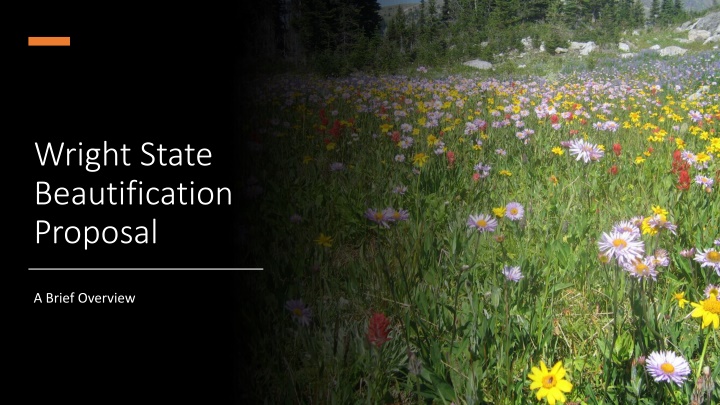Wright State Campus Beautification Proposal
This proposal focuses on reintroducing native plants, creating rain gardens, outdoor classrooms, and FSC plots at Wright State University. Examples from other universities, steps to be taken, considerations, and recommendations are also provided to enhance campus aesthetics and biodiversity.
Download Presentation

Please find below an Image/Link to download the presentation.
The content on the website is provided AS IS for your information and personal use only. It may not be sold, licensed, or shared on other websites without obtaining consent from the author.If you encounter any issues during the download, it is possible that the publisher has removed the file from their server.
You are allowed to download the files provided on this website for personal or commercial use, subject to the condition that they are used lawfully. All files are the property of their respective owners.
The content on the website is provided AS IS for your information and personal use only. It may not be sold, licensed, or shared on other websites without obtaining consent from the author.
E N D
Presentation Transcript
Wright State Beautification Proposal A Brief Overview
Summary Reintroduction of native plants and flowers into spaces that are not utilized Planting of rain gardens with salt tolerant plants to protect drinking water and Runkle Woods from runoff Installation of outdoor classrooms and recreational spaces for increased campus enjoyment Creation of FSC and cultural plots for campus
Examples in other universities Most Ivy Leagues Include biodiversity gardens focused around studies on ecology Usually include rain gardens, microhabitat restoration OSU/ UC/ OU Conducting beautification with natives and non- native, non- invasive Work with communities to increase biodiversity in surrounding areas (spillover) University of Arizona Increased biodiversity to help with aquifer regeneration This Photo by Unknown author is licensed under CC BY.
Steps to be taken GIS Survey of campus for the following: Sunlight hours and campus shade zones Traffic areas to consider planting Stormwater uptake and retention areas Unutilized grassy areas that can be converted Identify microclimates based on survey Work with ES and Bio to identify plants that are native and will have best chance of growing Work with landscape architect and budget to maximize effect This Photo by Unknown author is licensed under CC BY-SA.
Considerations Beautification and biodiversity can dramatically reduce lawn care budget for university Interdisciplinary studies can and should be developed with these techniques across colleges Great chance for student engagement to help design plots (adopt a plot) Excellent response from campus community Staging can reduce upfront cost
Recommendations Make beautification and biodiversity a priority in the master plan Focus on multiple use projects Rain gardens to protect groundwater from runoff while beautifying the drive into campus Eliminate ivy from planters to protect concrete while introducing new biodiversity Outdoor classrooms and sitting areas to increase time on campus Utilize campus resources Lots of grad students looking for projects This Photo by Unknown author is licensed under CC BY-SA-NC.























